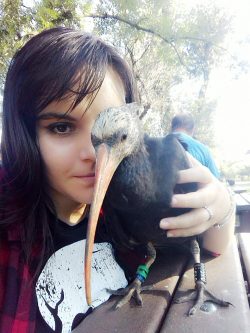On Sunday 15th October, BirdLife Malta received a call from football photographer Domenic Aquilina about a strange bird that had appeared at Ta’ Qali football grounds in the limits of Mosta. Photos sent quickly over the phone showed what appeared to be a Bald Ibis, unmistakable from its appearance, but quite unexpected as the bird has never ever been recorded on the Maltese Islands.

This photo and the one on the front page show Iris at Ta’ Qali on its arrival in Malta (Front page photo by Domenic Aquilina, this photo by Aron Tanti)
The Bald Ibis (Geronticus eremita) is a critically endangered species, with less than 300 birds left in the wild with remnant populations in Morocco, Turkey and Syria. The bird is considered as being extinct in Europe, with populations in the past believed to have inhabited particularly Southern Europe. As a result of attempts to repopulate and re-introduce them, nowadays small wild populations of this bird occur in Andalucia in Spain and in Austria, while over a thousand birds are registered from captive-breeding programmes in zoos and facilities.
Huge investments have been made into re-introducing the species including an ongoing LIFE project worth €4.4 million with project partners in Germany, Austria and Italy aimed at re-introducing a wild population of the Bald Ibis. Reared birds have been even trained using a delta-plane to migrate from Austria to Tuscany around the Alps, in what is turning out to be a successful project in repopulating this magnificent bird to Europe.

Nicole d’Amicis, the young student from the University of Bologna who hand-reared Iris, together with the Bald Ibis (Photo courtesy of Nicole d’Amicis)
Though incredulous, the bird in the photo sent by Domenic was unmistakable. While scrambling with local birdwatchers to confirm the sighting, and ensure it is safe, we made first contact with the LIFE Reason for Hope project, who in turn informed us that this bird bearing a black ring with numbers 015 was actually from another project in Italy. By the evening the bird had already started getting a lot of attention including from some notorious hunters who are known for their criminal record. Keeping this critically endangered bird safe was of paramount importance, and arrangements were made with Malta Football Association officials and police authorities, while staff and volunteers prepared for a night-long watch. Poised up on one of the stadium lights, snoozing away into the night, little did the Ibis know that intense discussions were going on metres away from it, trying to figure out its origin as well as a Maltese name for it. Indeed this rare species had never been recorded here to warrant it such a privilege.
The incredible story of Iris, the hand-reared Bald Ibis from Udine on a remarkable journey to the Maltese Islands
The ‘Velleran Eremita’, as it was later figured out, had originated from the Oasi dei Quadris in Fagagna (Udine) in North Eastern Italy – a place not unknown to us, following at least two occasions when White Storks originating from this centre had arrived to Malta in September 2014 and again in September 2016. In both occasions the Fagagna White Storks were injured or killed as a result of illegal hunting and having this critically endangered bird succumbing to a similar fate was not an option we wanted to risk. As morning set in, the bird made a return to the football grounds returning to its meal of earthworms and beetle larvae which it had an appetite for, pulling them out of the turf with its curved beak. Later that morning, the Ibis flew away with reported sightings of it pointing it had taken a direction south towards the airport. As much as the police could follow it, the bird was practically lost by then – leaving us hoping that it had migrated off the island safely.
A call later in the afternoon from a birdwatcher complaining the bird was not being guarded by the police was news to us that it had indeed made a return to the MFA football grounds once again. A second shift of watches ensued, with the Ibis once again deciding to spend its night on top of the stadium floodlights, safely away from anyone’s reach. By Tuesday morning, it was clear to us that this bird would not simply continue its migration, but possibly hang around Malta for longer. This was even more clear when further details about Iris, as we later learnt the bird was called, were received.
Iris was part of a 13-strong cohort of young Bald Ibises that were reared at the Oasi in 2017. The Oasi employs to task adoptive ‘parents’ who give a hand in raising Ibis chicks. Iris was under the responsibility of Nicole d’Amicis, hand-reared and completely accustomed to human presence.
This September a group of about 20 birds, a mix of young and older birds, decided to migrate south from the Oasi. This was mostly unexpected as these birds are imprinted to stay within the vicinity of the centre they are reared at, and are not totally accustomed to living in the wild, let alone migrate.
The journey undertaken by this group of birds was a remarkable one, which resulted in casualties for these inexperienced birds. Two birds are thought to have been shot at the Campania region near Naples, with one currently undergoing care to a shotgun injury to its wing. Another two birds were electrocuted with one found dead, and another succumbing to its injuries after being rescued. Up to 15 birds are known to have reached Calabria in Southern Italy. Latest news point to a few individuals at the Aeolian Islands in Sicily, one bird in Palermo, and Iris ending up in Malta, or rather Gozo, where it decided to relocate on the 17th October – in no other welcoming scenario than the Xewkija football stadium.
At this point in time, considering the various circumstances revolving around this bird, a brave decision was taken with the involvement of the Malta Police Force; the Wild Birds Regulation Unit (WBRU) in the Ministry for the Environment, Sustainable Development and Climate Change; and the Oasi dei Quadris to recover this bird to safety. The fact that this rare, critically endangered bird arrived in Malta at a time when illegal hunting made a haunting return this autumn season, meant that the stakes were high for it on the taxidermy market. Add to it the fact that it was a highly valued ringed specimen, and that it seemed it was ready to venture all around the Maltese Islands, unbothered and unafraid of humans – it was truly a question of time until the bird decided to leave the safety of the football grounds and venture into less friendly rural areas.
Following an overnight venture in Gozo, its love for beetle larvae at the Xewkija football ground the morning of the 18th October allowed us to prepare ahead for its recovery, aided by some very useful tips provided by the Oasi personnel to BirdLife Malta. In the presence of WBRU officials, Iris was recovered to safety and subsequently kept under our custody, until arrangements were made to send Iris back to Italy at its centre of origin.
Once again, communications with the Oasi were crucial in ensuring Iris was fed and given the best of care, and accordingly prepared for its flight off Malta – a place it managed to wander off to unexpectedly, separating from its similars. Following a vet examination, and checks carried out by ALE and ERA officers, Iris boarded a one-way flight to Linate Airport on the morning of the 25th October.
At BirdLife Malta, we were happy to celebrate the successful repatriation of this otherwise lost bird – a much needed jubilation following the stream of shot protected birds that have characterised this October. Indeed a flock of the more common Glossy Ibises were shot at, the next morning in Marsalforn valley in Gozo – with one person being investigated by police following reports made.
Despite opposing views from those who cannot fathom our mission to save birds, no one can dispute that this critically endangered bird, which ended up making a record presence on Malta, demanded the full cooperation of BirdLife Malta and government authorities to make sure it survived to continue repopulating the species. And indeed we succeeded in our mission! Let’s augur it serves its purpose to bring this species back from the brink of extinction, under the good care of our friends at the Oasi dei Quadris in Udine.
Click here to watch a video narrating the whole story of Ibis.
By Nicholas Barbara, BirdLife Malta Conservation Manager
(This blog post was originally published by the Malta Independent on Friday 27th October 2017)




